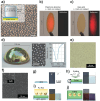Bottom-Up Metasurfaces for Biotechnological Applications
- PMID: 39921422
- PMCID: PMC11884530
- DOI: 10.1002/advs.202413679
Bottom-Up Metasurfaces for Biotechnological Applications
Abstract
Metasurfaces are the 2D counterparts of metamaterials, and their development is accelerating rapidly in the past years. This progress enables the creation of devices capable of uniquely manipulating light, with applications ranging from optical communications to remote biosensing. Metasurfaces are engineered by rational assembly of subwavelength elements, defined as meta-atoms, giving rise to unique physical properties arising from the collective behavior of meta-atoms. These meta-atoms are typically organized using effective, reproducible, and precise nanofabrication methods that require a lot of effort to achieve scalable and cost-effective metasurfaces. In contrast, bottom-up methods based on colloidal nanoparticles (NPs) have developed in the last decade as a fascinating alternative for accelerating the technological spread of metasurfaces. The present review takes stock of recent advances in the fabrication and applications of hybrid metasurfaces prepared by bottom-up methods, resulting in disordered metasurfaces. In particular, metasurfaces prepared with plasmonic NPs are emphasized for their multifold applications, which are discussed from a biotechnology perspective. However, some examples of organized metasurfaces prepared by merging bottom-up and top-down approaches are also described. Finally, leveraging the historical disordered metasurface evolution, the review draws new perspectives for random metasurface design and applications.
Keywords: biosensing; biotechnologies; metasurfaces; optics; pathogens; photo‐thermal; plasmonics.
© 2025 The Author(s). Advanced Science published by Wiley‐VCH GmbH.
Conflict of interest statement
The authors declare no conflict of interest.
Figures








References
-
- Katiyi A., Karabchevsky A., In Reference Module in Materials Science and Materials Engineering, Elsevier, Amsterdam, 2022.
-
- Qin F., Peng H.‐X., Prog. Mater. Sci. 2013, 58, 183.
-
- Govindaraman L. T., Arjunan A., Baroutaji A., Robinson J., Olabi A.‐G., In Encyclopedia of Smart Materials, Elsevier, Amsterdam, 2022, 2, pp. 522–534.
-
- Nemati A., Wang Q., Hong M. H., Teng J. H., Opto‐Electron. Adv. 2018, 1, 180009.
-
- Kuznetsov A. I., Brongersma M. L., Yao J., Chen M. K., Levy U., Tsai D. P., Zheludev N. I., Faraon A., Arbabi A., Yu N., Chanda D., Crozier K. B., Kildishev A. V., Wang H., Yang J. K. W., Valentine J. G., Genevet P., Fan J. A., Miller O. D., Majumdar A., Fröch J. E., Brady D., Heide F., Veeraraghavan A., Engheta N., Alù A., Polman A., Atwater H. A., Thureja P., Paniagua‐Dominguez R., et al., ACS Photonics 2024, 11, 816. - PMC - PubMed
Publication types
Grants and funding
LinkOut - more resources
Full Text Sources
Miscellaneous
